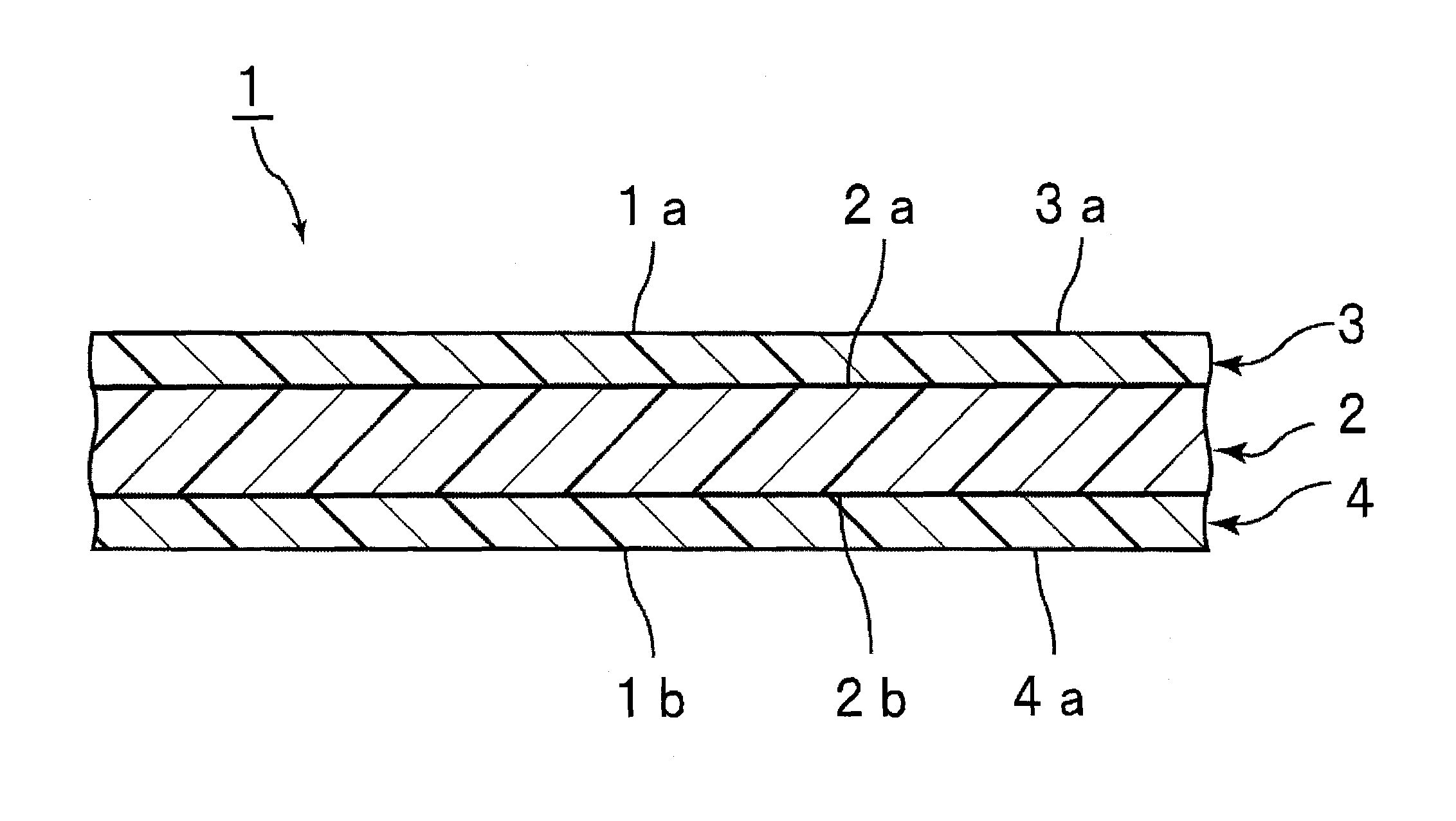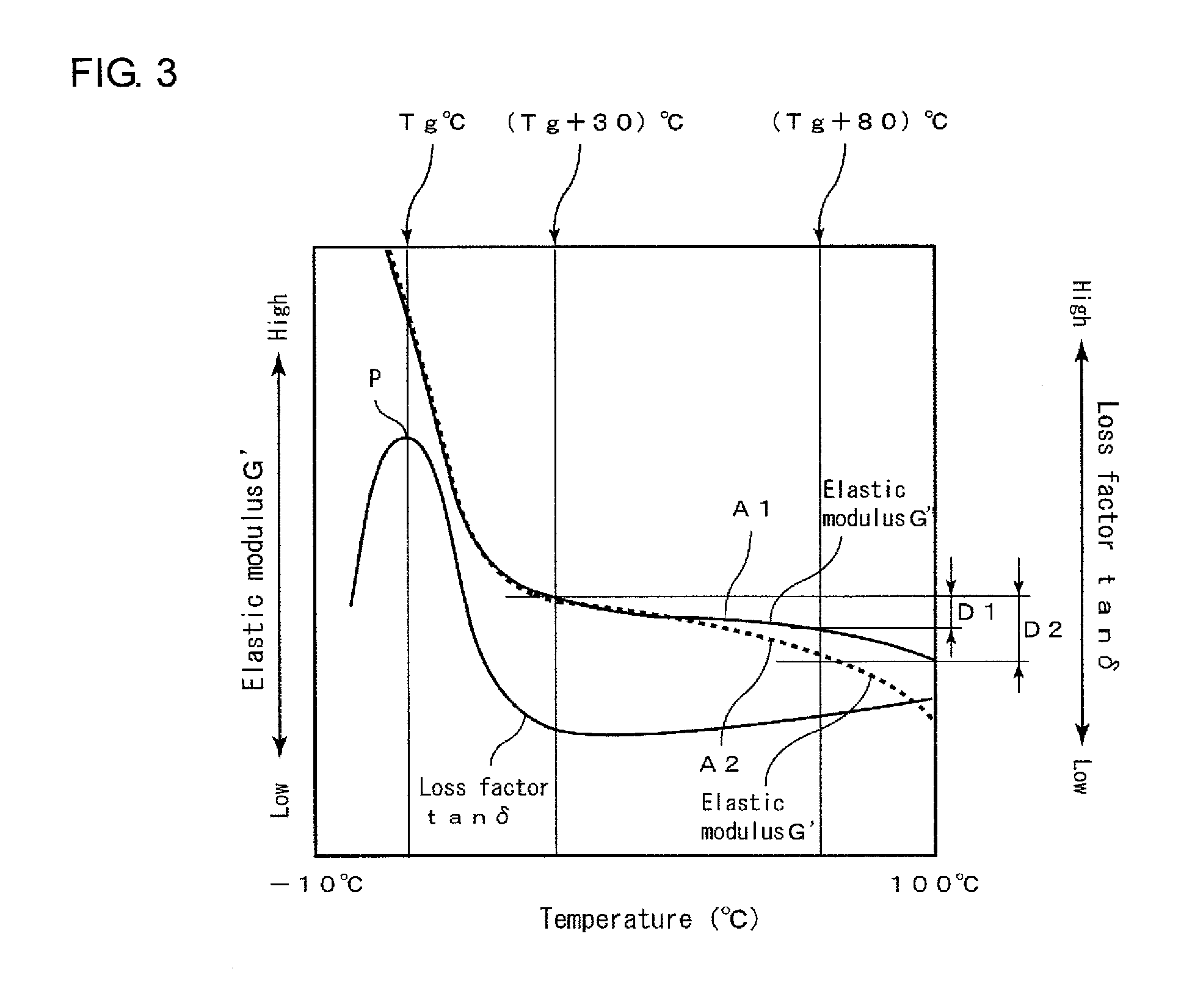Laminated glass interlayer and laminated glass
a technology of laminated glass and interlayers, which is applied in the field of intermediate films for laminated glass, can solve the problem of disadvantageously insufficient sound insulation properties of sound at a register of about 5,000 hz
- Summary
- Abstract
- Description
- Claims
- Application Information
AI Technical Summary
Benefits of technology
Problems solved by technology
Method used
Image
Examples
synthesis example 1
Synthesis of Polyvinyl Acetal Resin d1
[0216]A polyvinyl butyral resin (average degree of polymerization: 3,000) having a degree of acetylation of 0.5 mol %, a degree of butyralization of 40 mol %, and a hydroxy group content of 59.5 mol % was dissolved in pyridine. To the dissolved polyvinyl butyral resin was added 30 mol equivalents of acetic anhydride, and the mixture was stirred at 80° C. for 120 minutes. The pyridine was removed, and then the polyvinyl butyral resin was washed with water and dried. Thereby, a polyvinyl butyral resin d1 (average degree of polymerization: 3,000) was obtained. With respect to the obtained polyvinyl butyral resin d1, the degree of butyralization was 40 mol %, the degree of acetylation was 30.5 mol %, and the hydroxy group content was 29.5 mol %.
synthesis example 2
Synthesis of Polyvinyl Acetal Resin d2
[0217]A polyvinyl butyral resin (average degree of polymerization: 3,000) having a degree of acetylation of 0.5 mol %, a degree of butyralization of 40 mol %, and a hydroxy group content of 59.5 mol % was dissolved in pyridine. To the dissolved polyvinyl butyral resin was added 33 mol equivalents of acetic anhydride, and the mixture was stirred at 80° C. for 120 minutes. The pyridine was removed, and then the polyvinyl butyral resin was washed with water and dried. Thereby, a polyvinyl butyral resin d2 (average degree of polymerization: 3,000) was obtained. With respect to the obtained polyvinyl butyral resin d2, the degree of butyralization was 40 mol %, the degree of acetylation was 33.5 mol %, and the hydroxy group content was 26.5 mol %.
synthesis example 3
Synthesis of Polyvinyl Acetal Resin e1
[0218]To 2,890 g of pure water were added 95.5 g of polyvinyl alcohol with a degree of polymerization of 2,500 and a degree of saponification of 99.2 mol % and 100 g of polyvinyl alcohol with a degree of polymerization of 3,500 and a degree of saponification of 99.2 mol %, and then the mixture was heated so that the polyvinyl alcohols were dissolved into the pure water. The temperature of the solution was controlled to 12° C. To the solution were added 220 g of 35 wt % hydrochloric acid and 160 g of n-butyl aldehyde, and a polyvinyl butyral resin was precipitated. Thereafter, the resin was kept at 50° C. for 3 hours, and the reaction was finished. The resin was washed with excess water so that unreacted n-butyl aldehyde was washed away. The hydrochloric acid catalyst was neutralized so that the salt was removed, and then the product was dried. Thereby, a polyvinyl butyral resin e1 was obtained. With respect to the obtained polyvinyl butyral resi...
PUM
| Property | Measurement | Unit |
|---|---|---|
| cloud point | aaaaa | aaaaa |
| cloud point | aaaaa | aaaaa |
| temperature | aaaaa | aaaaa |
Abstract
Description
Claims
Application Information
 Login to View More
Login to View More - R&D
- Intellectual Property
- Life Sciences
- Materials
- Tech Scout
- Unparalleled Data Quality
- Higher Quality Content
- 60% Fewer Hallucinations
Browse by: Latest US Patents, China's latest patents, Technical Efficacy Thesaurus, Application Domain, Technology Topic, Popular Technical Reports.
© 2025 PatSnap. All rights reserved.Legal|Privacy policy|Modern Slavery Act Transparency Statement|Sitemap|About US| Contact US: help@patsnap.com



